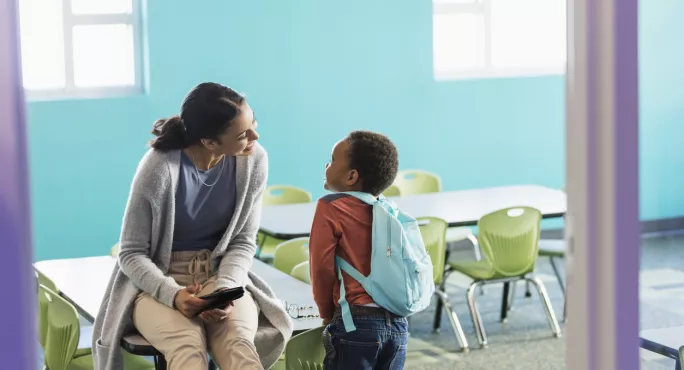- Home
- Teaching isn’t about ‘vision’ - it’s about seeing
Teaching isn’t about ‘vision’ - it’s about seeing

Within teaching there is always much talk about vision.
School leaders, governors and senior teams spend months wrangling with visions. Courses, books, and training sessions claim they will be instrumental in helping you to clarify, set and communicate your vision.
Schools’ accountability reports often refer to a clarity of vision, and governments often speak of a vision for education and young people.
If you look at the language associated with teaching, there are myriad words and phrases associated with vision and looking and seeing: visualisers, book looks, scrutinies, deep dives looking to find evidence of the impact of a vision.
Yet, in all this looking, there is a danger that we forget to notice. Because teaching and learning is about noticing.
Seeing, but not observing
It is not about always about a crisply developed performance delivered to a waiting class. Nor is it about ticking boxes, completing endless monitoring reports and ensuring that staff are deep-dive ready.
No, teaching is not about seeing - it’s about noticing. The greatest teachers are the ones who don’t just see the children and the scheme of work and the hoops through which everyone is being asked to jump.
Great teachers are noticers, not seers. They are the ones who notice the child who arrives hungry, or picks up on the almost imperceptible change in attitude after the arrival of a new sibling or the loss of a beloved pet.
They are the ones who notice the slight shift in peer and friendship dynamics, and how this causes the ever-so-tiny slide in concentration or outcomes. They are the ones who notice that there is still Monday’s dinner and paint stuck to Friday’s jumper, or that the yawning is happening more frequently.
They are the ones who notice that the children smile or retain more when they teach in a certain way. They are the ones who plan a strategic ebb and flow to the rhythm of their days and weeks, to ensure that children have both the thrill of new learning and also periods of quiet concentration and reflection.
These teachers are the ones who know their data, but also know that their data is not a number but a child, and that therefore each number is actually a story.
A humane profession
These brilliant professionals adjust their teaching, their tone and their approach to ensure that these children are not just tracked and taught, but are noticed and celebrated.
Seeing is easy in teaching. Showing is easy in teaching. We see the curriculum we need to teach. We demonstrate and instruct and revisit and retrieve, and we track and analyse and adjust, but we must never forget to notice.
As these children pass through our classrooms, each one will be a unique story, they bring not only their knowledge and their ability to learn, but also themselves. It is our job to take the time to notice who they are, and to care about noticing.
In a high-stakes accountability culture, and in periods of huge flux and shifts in discussions around teaching, we must hold on to the fact that it is ultimately a humane profession.
We need to model this through our pedagogy, our enactment of the curriculum and the investment we make into building effective relationships with our learners and communities.
The importance of simply noticing
In an overcrowded curriculum, and with so many pulls on time, energy, resources and reserves causing our attention to be pulled in so many different directions, it can be easy to overlook the importance of simply noticing.
But, when we stop noticing, we stop learning about our pupils - we sideline the human aspect of our roles and prioritise the production-line-style seeing and doing.
Noticing is therefore one of the most skilful aspects of a great teacher. But it is also one which, in the rush of the day-to-day busyness of teaching, can become overlooked.
Noticing is also an all too easily overlooked investment. Those teachers who can seemingly have meaningful words with pupils outside lessons - whether about a football team’s performance or the health of a relative - are the ones who often ultimately have the most successful lessons.
The relationships at the heart of great teaching
Because, at the heart of all great teaching, there are great relationships.
These are not built by the rushed teacher determined to ensure that all groups meet their targets by the next data drop. Rushing through the busyness of a day gives us little time to invest in that which can pay huge dividends - the business of noticing.
Ten minutes on a playground at lunchtime can tell us more about our class dynamics and drivers than any well planned PSHE or circle-time activity.
Eating in the dinner hall on occasion can give us so much information about wellbeing, friendship groups, relationships and other pulls on children’s attention.
Taking the time to chat with pupils, not only about their learning but also about their lives, can help us to target our teaching so much more effectively.
So in these times of packed curriculum, rapid pace of change and squeezed resources, we must never underestimate the importance of investing in quiet noticing and simply taking note.
“What is this life if, full of care,
We have no time to stand and stare.”
Emma Turner is the research and CPD lead for Discovery Schools Trust, Leicestershire. She tweets @Emma_Turner75
Keep reading for just £1 per month
You've reached your limit of free articles this month. Subscribe for £1 per month for three months and get:
- Unlimited access to all Tes magazine content
- Exclusive subscriber-only stories
- Award-winning email newsletters



